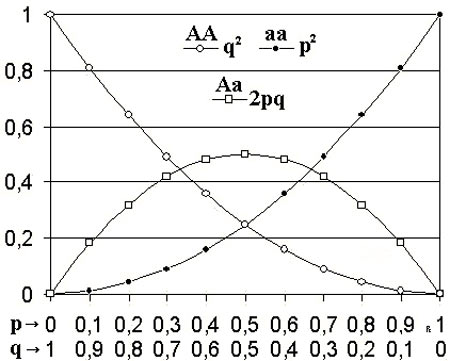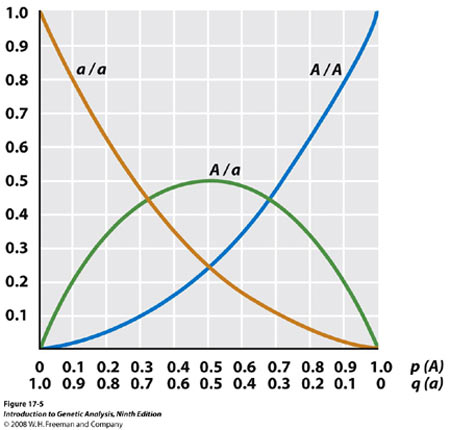
by Greg Green
Hardy-Weinberg equilibrium
An understanding of breeding concepts requires a basic understanding of Hardy- Weinberg’s Equilibrium. Breeding depends upon the knowledge of population genetics. To understand the value of the H/W Equilibrium, you may have to ask yourself a question like this before.
If certain diseases are a dominant trait, then why haven’t large sections of the population got this disease?
The same question applies to cannabis breeding. If purple bud colour is a dominant trait then how come my offspring from the purple bud strain do not have purple buds? Or, I have been selecting Indica mothers and cross breeding them with mostly Indica male plants but I have some sativa leaves. Why does this happen? Hardy-Weinberg’s Equilibrium will help you to understand these questions and there answers.
Okay, first of all these questions reflect a very common misconception. That misconception is that the dominant allele of a trait will always have the highest frequency in a population and the recessive allele will always have the lowest frequency.
There is no logic behind the idea that a dominant trait should show a tendency to spread over a whole population. Also there is no logic behind the idea that a recessive trait should die out.
Gene frequencies can be in high ratios or low ratios no matter how the allele is expressed. The allele can also change, depending on certain conditions. It is the changes in gene frequencies over time that result in different plant characteristics.

Hardy-Weinberg Equilibrium will show us whether or not gene frequencies have changed in a population.
A population is a group of individuals of the same strain or species, [such as cannabis Indica or cannabis sativa (species), or Skunk#1 and Master Kush (strains of a species)], in a given area whose members can interbreed with one another. This means that they share a common group of genes. This common group of genes is known as the GENE POOL. Each gene pool contains all the alleles for all the traits of all the population
For a step in evolution to occur some of the gene frequencies must change. That is why we have different types of cannabis plants.
The gene frequency of an allele refers to the number of times an allele for a particular trait occurs compared to the total number of alleles for that trait.
Gene frequency is calculated as follows.
The number of a specific type of allele, divided by, The Total number of alleles in the gene pool.
The Hardy and Weinberg principal describes a theoretical situation in which there is no change in the gene pool. This means that there can be no evolution.
For a test example let us consider a population whose gene pool contains the alleles B and b. Assign the letter c to the frequency of the dominant allele B and the letter d to the frequency of the recessive allele b. [In most cases you will find that c and d are actually notated as p and q by convention in science, but for this example we will use c and d.]
The sum of all the alleles must equal 100%.
So c + d = 1.
All the random possible combinations of the members of a population would equal (c x c) + 2cd + (d x d). Which can also be expressed as: (c+d) X (c+d)
We will explain this in detail in moment, but it is best to know it for now.

The frequencies of B and b will remain unchanged generation after generation if:
1. The population is large enough.
2. There are no mutations.
3. There are no preferences. For example a BB male does not prefer a bb female by its nature.
4. No other outside population exchanges genes with this model.
5. Natural selection must not favour any specific individual.
Let us imagine a pool of genes. 12 are B and 18 are b. Now remember The sum of all the alleles must equal 100%. So this means that the total in this case is 12 + 18 = 30. So 30 is 100%.
If we want to find the frequencies of B and b and the genotypic frequencies of B, Bb and b then we will have to apply the standard formula that we have just been shown.
f (B) = 12/30 = 0.4 = 40%
f (b) = 18/30 = 0.6 = 60%
Both add to make 100%. Now we know their ratios.
So, c + d = 0.4 + 0.6 = 1
We have proven that c + d must equal 1. Very straightforward, yes.
Remember that all the random possible combinations of the members of a population would equal (c x c) + 2cd + (d x d), or (c+d) X (c+d)
Then, c + d = 0.4 + 0.6 = 1
And (c x c) + 2cd + (d x d)
= BB + Bb + bb
= .24 + .48 + .30 = 1
This means that the population can increase in size, but the frequencies of B and b will stay the same.
Now, suppose we break the 4th law about not introducing another population into this one.
Let us say that we add 4 more b.
b + b + b + b enter the pool. This brings our total up to 34 instead of 30. What will the gene and genotypic frequencies be?
f (B) = 12/34 = .35 = 35 %
f (b) = 22/34 = .65 = 65%
f (BB) = .12, f (Bb) = .23 and f (bb) = .42
Oppss, .42 does not equal 1. This means that the Equilibrium law fails if the 4th law is not met. When the new genes entered the pool it resulted in a change of the population’s gene frequencies. However if no other populations where introduced then the frequency of .42 would be maintained generation after generation
However we would like to point out that we used a very small pool in the above example. If the pool were much larger then the number of changes, even if one or two new genes jumped in, would be insignificant. You could calculate it, but the change would be on an extremely low level 0.000000000001 of a difference in reality
This is just as basic example to get you started. It may not make complete sense at first but if you read on then it will fall into place. Some of you may be asking the question.
How do I know if a trait, such as bud colour is Homozygous Dominant (BB), or Heterozygous (Bb) or Homozygous Recessive, (bb)?
If you have been given seeds or a clone you may have been told that a trait, such potency is Homozygous Dominant, Heterozygous or Homozygous Recessive. However, you will want to prove this to yourself. Especially if you are going to use that plant in a future breeding plan. You will have to do what is called a Test Cross.

